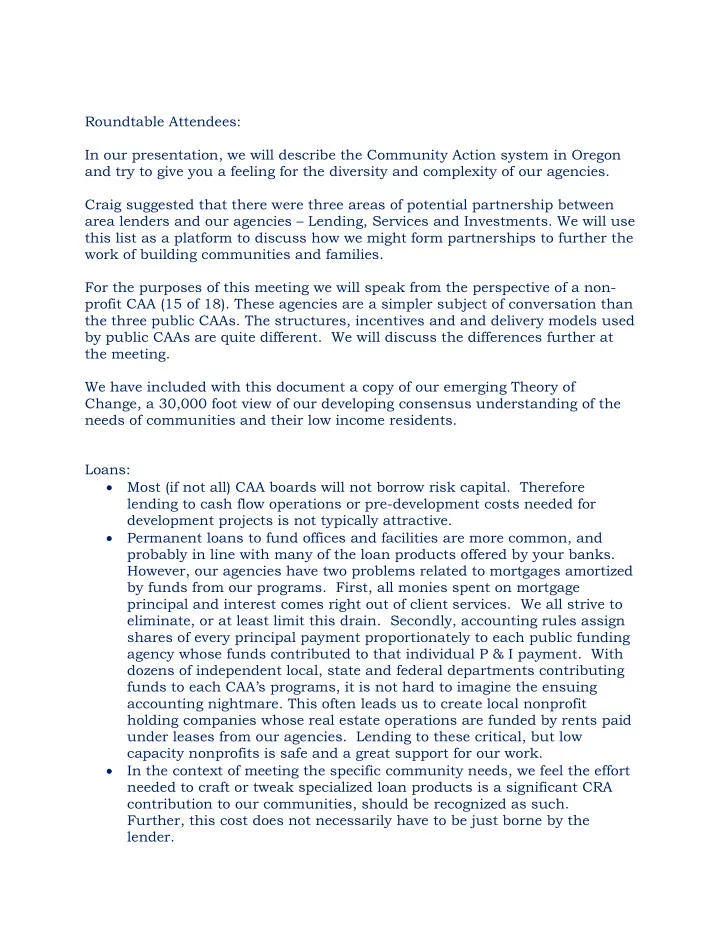

Roundtable Attendees: In our presentation, we will describe the Community Action system in Oregon and try to give you a feeling for the diversity and complexity of our agencies. Craig suggested that there were three areas of potential partnership between area lenders and our agencies – Lending, Services and Investments. We will use this list as a platform to discuss how we might form partnerships to further the work of building communities and families. For the purposes of this meeting we will speak from the perspective of a non- profit CAA (15 of 18). These agencies are a simpler subject of conversation than the three public CAAs. The structures, incentives and and delivery models used by public CAAs are quite different. We will discuss the differences further at the meeting. We have included with this document a copy of our emerging Theory of Change, a 30,000 foot view of our developing consensus understanding of the needs of communities and their low income residents. Loans: • Most (if not all) CAA boards will not borrow risk capital. Therefore lending to cash flow operations or pre-development costs needed for development projects is not typically attractive. • Permanent loans to fund offices and facilities are more common, and probably in line with many of the loan products offered by your banks. However, our agencies have two problems related to mortgages amortized by funds from our programs. First, all monies spent on mortgage principal and interest comes right out of client services. We all strive to eliminate, or at least limit this drain. Secondly, accounting rules assign shares of every principal payment proportionately to each public funding agency whose funds contributed to that individual P & I payment. With dozens of independent local, state and federal departments contributing funds to each CAA’s programs, it is not hard to imagine the ensuing accounting nightmare. This often leads us to create local nonprofit holding companies whose real estate operations are funded by rents paid under leases from our agencies. Lending to these critical, but low capacity nonprofits is safe and a great support for our work. • In the context of meeting the specific community needs, we feel the effort needed to craft or tweak specialized loan products is a significant CRA contribution to our communities, should be recognized as such. Further, this cost does not necessarily have to be just borne by the lender.
• Our agencies and our community partners already take advantage of a variety of loan products. The challenge for lenders is that our work is often ad hoc and does not always offer lenders advantages of scale, e.g. MMT/ShoreBank (Craft3) $400k loan to allow one of our members to deliver bridge loans to flood victims elevating their homes with federal support. • Lending to public or quasi-public entities for small scale infrastructure projects is another important need. Institutional lending to cities, counties and districts can often be difficult, but at least this market has institutional support from the state. However, the needs of individual property owners to manage the assessed costs of lateral replacement and hook-up during sewer replacement projects is frequently a problem. So are costs associated with septic tank repair and replacement. At least some of our agencies are interested in finding ways to channel large capital investments to small individual consumers to address these needs. • Craig, (or someone in the run up to this meeting) suggested that lenders could provide liquidity to a loan pool managed by a CAA. This is an interesting idea, although most CAAs see these loan pools as a trust and will be concerned about risking the long term asset for short term gain. • Loans to construct affordable housing are a perennial need. These can be especially tough in rural communities. Partnerships with sympathetic construction and permanent lenders early in the development process could help our rural communities and smaller project sponsors compete for funding. Services • Every CAA executive director worries about maintaining their agency board’s capacity to understand our complex financials. Board service by an interested and engaged financial expert is a great help to us. • Most, if not all Oregon CAAs are attractive to banks servicing our corporate deposits, credit cards, etc. However, special consideration for some of our small scale banking needs would be a great help. He nonpfit holding companies mentioned above and our IDA programs are a good example. Lending to first time homebuyers and sweat equity borrowers is another area which delivers big programmatic returns. Investments • Grants and program funding are always a need. Support (particularly on- going support) for our homeownership centers is an effective synergistic grant opportunity. • Sponsoring workshops for low- and moderate income individuals • Sponsoring training for agency employees is another intriguing idea.
• Donations of office furniture, fixtures and equipment can often help. However, we have the same productivity pressures as for profit companies and are offices often surprisingly modern. Please ask. • Purchase of a bond that supports the construction of a facility or affordable housing would also make a significant difference.
Recommend
More recommend